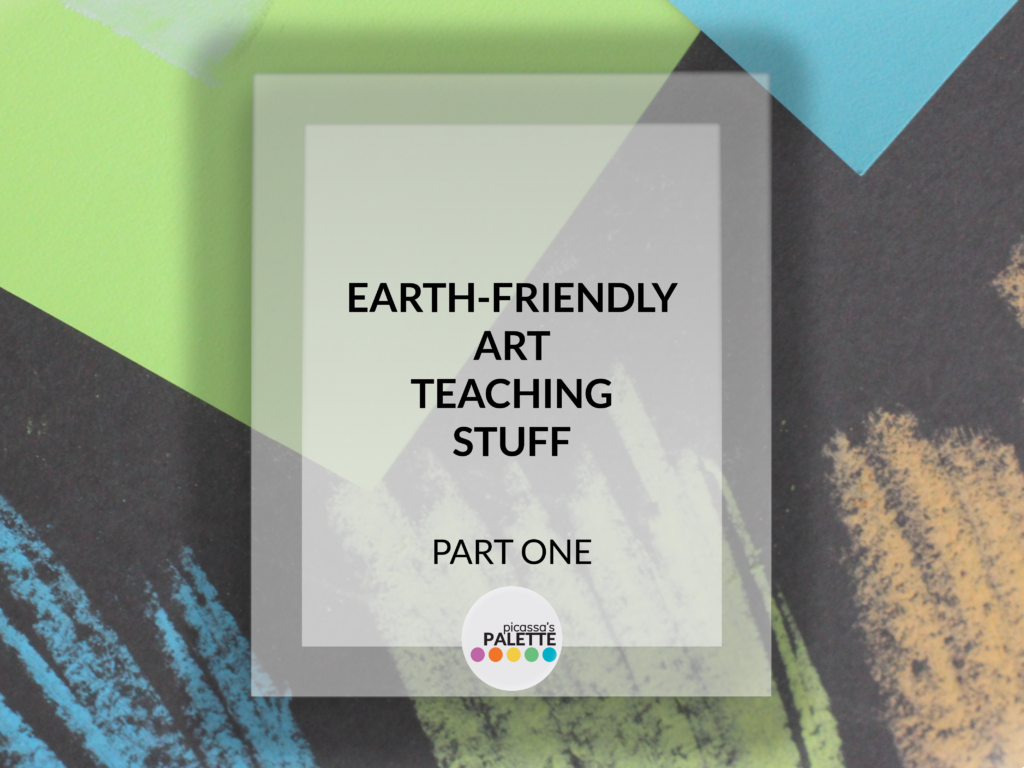
Earth-Friendly and Budget-Conscious Art Teaching Stuff…
Part 1: Art Project Supplies To Request from Home (or Homeroom Teachers)
Free and/or WIDELY Available Art Classroom Materials & Supplies
I’m writing this in April, and this year’s Earth Day got me thinking a lot about the importance of eco-friendly art supplies and art-making materials.
A cool thing is that if we each do a little bit, we can collectively do A LOT to reduce waste and decrease the overall environmental impact of art classrooms.
To me, that’s a pretty powerful and unifying thing…
So, here’s a list I came up with about a bunch of Earth-friendly, free and/or WIDELY available Art Classroom Materials and Supplies, along with their best features and a few practical ideas for their uses…
FREE Art Project Supplies To Request from Home:
-Magazines-
Features:
Glossy
Easily Tear-out able (but low-waste due to amount of pages)
Uses:
Paint Palettes
Printmaking Plates
-Paper Towel Rolls-
Features:
not as gross as toilet paper rolls
Uses:
“as stamps for creating geometric patterns, or use them as armatures for sculpture projects”
-Fabric Scraps-
Features:
Saves tons of money- fabric for groups of students is super expensive- even purchased in bulk.
*Note: Collect old clothes only if you (or your volunteers) have the time/energy to cut them down into useable and storable pieces.
Uses:
Great for teaching texture vocab
Useful tools for tactile / sensory learning- as pattern/material examples, as texture examples, etc.
Textile-based art projects like quilting, weaving, or fabric collage.
-Extra Buttons-
Features:
Saves money… a pack of these can run pretty expensive.
Eco- concious to repurpose and keep from refuse.
Encourages students to build focused collections of everyday items, in a considerate way.
Uses:
Mixed Media Artwork Projects
3D Mixed Media Sculptures
–Plastic Bottle Caps–
Features:
Easy to store
Otherwise contribute to plastic pollution
You’ll have more of them everytime you inventory your used markers or gluesticks.
Use:
create mosaics, sculptures, as stamps for printmaking
-Egg Cartons–
Features:
Foam or Paper
Uses:
paint mixing palettes
cut up lids to create textured surfaces for painting
like a gazillion more repurposable (probably erring on ‘crafty’) uses available over on pinterest
-Bottle Corks–
Uses:
Create stamps for paint, clay, ink, etc. by adding foam stickers, buttons, sequins, etc.
Easily used as a subtractive material for sculptures or other 3D artwork.
Construct cork boards – with your handy glue gun, you can attach these to a wall and use them to staple up a hall display of student artwork, or tack up evidence of student learning in your classroom, or even to add notes to “Center” areas, scavenger hunt clues, etc.
–Old Calendars, Old Planners–
Features:
Usually self-contained with a spiral binding
Uses:
Repurpose as sketchbooks for drawings or for attaching drawings to pages to create student collection/ series/ portfolios/ art journals, etc.
Use to collect collage materials by attaching envelopes to hold small pieces.
Use as canvas surfaces for painting
Tear pages for making paper beads
-Chopsticks, Plastic Utensils, Wrapped Straws–
Request their extra unused packs from takeout orders or corner stores
Features:
Easy enough to store
Otherwise contribute to plastic pollution
Uses:
Endless project materials
as alternative paintbrushes
Clay / sculpting tools
EEEK… IDEAS on what to stay away from (and why):
Some of these are merely personal preference, but…
– Glass Jars and Bottles-
Obviously they can shatter, break and risk injury…. theirs and/or yours, ’nuff said?
-Cans-
They have metal edges… see above (glass jars, bottles)
-”Go” Cups-
Here in Nola they’re known as GO-Cups… because you take them with your drinks “To-Go”. they’re any kinda plastic cups that are thrown during Mardi Gras parades that promo businesses, events, or krewes/clubs … But basically everywhere else, they are probably called Kiddie Cups or Plastic Cups – you know, the kind of thicker plastic cups that can be rewashed and reused and stored in the kitchen cabinet. Regarding their usability: To me, they’re basically only worth keeping if they are a class set quanitity of same-sized duplicates, due to the almost-always-limited availibility of classroom art supply storage space. …Honestly, if I kept them all, I’d surely find them avalanching down on me from every single art supply storage cabinet daily.
-Old Tees or Button Downs-
Sometimes teachers collect these types of shirts for uses as “smocks” …but to me, especially for the littles, it always ended up being a huge waste of time in selecting, dressing them into, washing/drying, storing, etc. There’s about a gazillion other ways for your artists to stay clean-ish.
-Edible (or Formerly Used With Edible) Materials and Food-
Have you ever had a mouse in your art room? Do you want one? 😉
Setting An Example
As long as we’re reflecting on our impact on the environment, we might as well consider the materials we use in our art classrooms. When we utilize eco-friendly supplies like the repurposed things above, we not only reduce waste, but also teach our students valuable lessons about sustainability and resourcefulness.
By encouraging our students to bring in these Earth-friendly materials from home or request extras of them from homeroom teachers, we can easily set an eco-aware example by fostering a culture of environmental stewardship in our art classrooms.
Go ahead and check out Part II!
Part II: Equipment To Repurpose (or Find for Cheap) for the Art Room
Recommendations for eco-conscious, low-cost and/or free Reusable Art Classroom Materials & Equipment Ideas… and how they can be used.